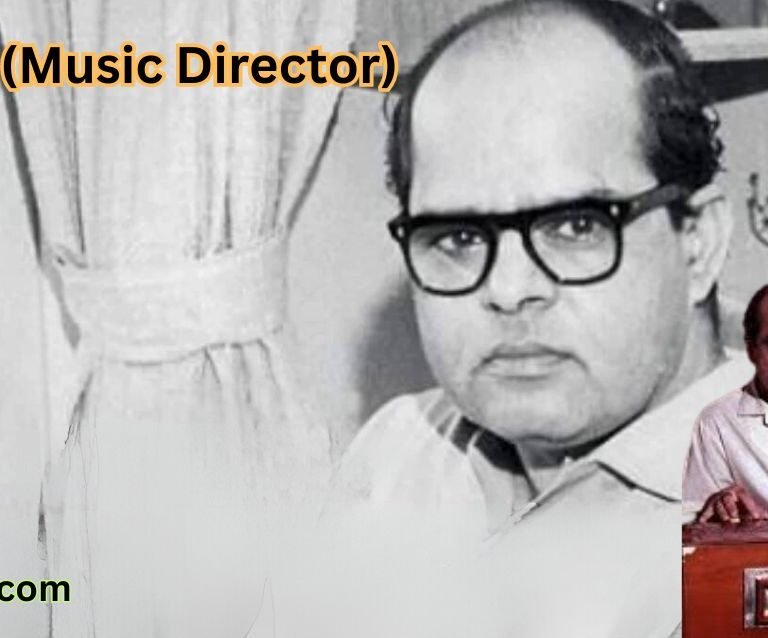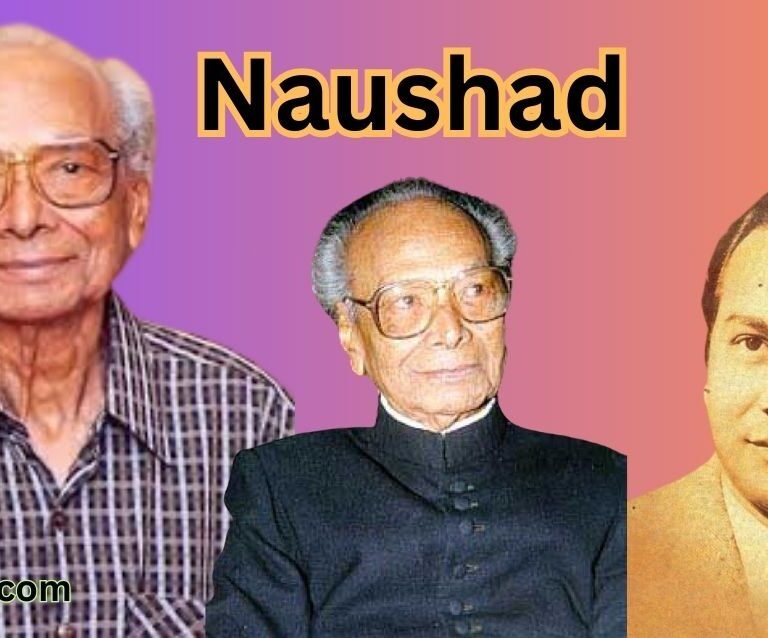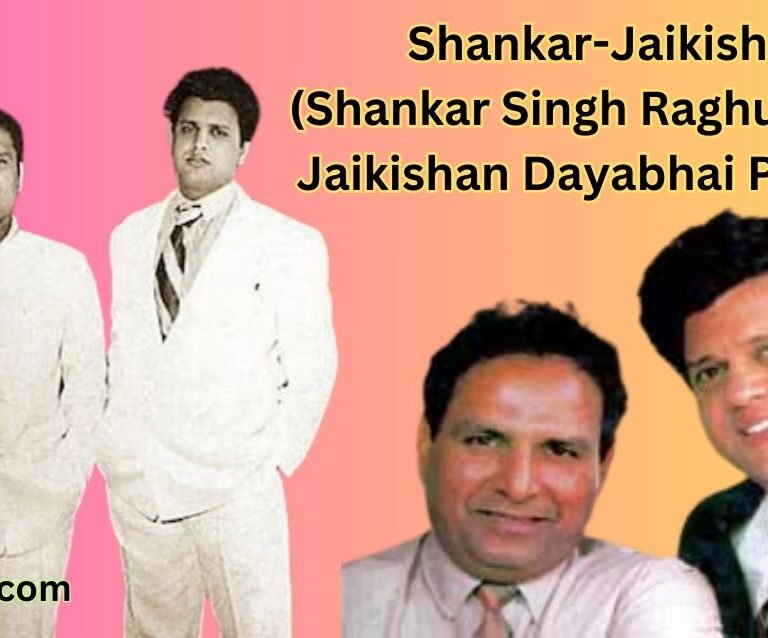S.D. Burman
Born in 1906 in the picturesque town of Comilla, Bengal (now in Bangladesh), Sachin Dev Burman, popularly known as S.D. Burman, left an indelible mark on the world of Indian music. Hailing from a princely family, Burman was immersed in the rich cultural heritage of his homeland from an early age, which profoundly shaped his musical journey. His initial foray into music was influenced by his father, Nabadwipchandra Dev Burman, an accomplished sitar player, and the traditional folk music of Bengal, which deeply resonated with him.
Burman’s formal training in music began under the tutelage of the renowned musician, K. C. Dey, and was later polished by his learning from the legendary Ustad Allauddin Khan of the Maihar Gharana. This rigorous classical training enabled Burman to master the intricacies of Indian classical music, which he skillfully integrated into his compositions throughout his career. His music has remained a sublime blend of classical ethos and folk simplicity, which elevated his status as a versatile composer.
The early 1940s witnessed Burman’s transition into the world of film music, a move that would cement his legacy as one of the most significant music directors in Hindi cinema. His unique ability to meld classical, folk, and contemporary musical styles enabled him to craft timeless melodies that continue to enchant audiences. Burman’s compositions, characterized by their lyrical beauty and emotive power, have graced numerous classic films, earning him critical acclaim and a devoted following.
As a luminary in the realm of Hindi cinema, S.D. Burman’s influence transcended generations and genres. His innovative approaches to music composition and his profound understanding of the emotional contours of cinema set him apart as a musical genius. Burman’s illustrious career not only enriched the Indian music landscape but also left an enduring legacy that continues to inspire and enthrall music lovers worldwide.
Blending Folk and Classical Music
S.D. Burman, a revered figure in Indian music, demonstrated an unparalleled ability to effectively merge Indian folk music with classical ragas. His innovative approach brought a refreshing sound to Hindi cinema, resonating deeply with diverse audiences. Burman’s music encapsulated the essence of India’s rich cultural tapestry, embracing both rural and classical traditions to create something uniquely resonant.
One exemplary instance of this blend is the song ‘Jeevan Ke Safar Mein Rahi’. The song seamlessly integrates folk melodies with classical ragas, crafting an auditory experience that simultaneously feels familiar and innovative. The folk elements lend an earthy, accessible feel, while the classical components add a layer of depth and sophistication. This harmonious blend enabled the music to transcend typical genre constraints, appealing to both connoisseurs of classical music and enthusiasts of folk traditions.
‘Sun Mere Bandhu Re’ serves as another stellar example of Burman’s genius. The song employs a classical base yet flirts with folk elements, creating a mesmerizing balance. The raga influences are unmistakable, providing a solid foundation while the folk nuances add character and relatability. This combination not only broadened the appeal of his music but also underscored Burman’s masterful understanding of both genres.
Burman’s artistry in blending these divergent styles was not merely for creative novelty; it reflected a deep-seated cultural synthesis. During a time when Indian society was undergoing rapid transformation, Burman’s music stood as a harmonious bridge connecting the evolving urban sensibilities with traditional rural roots. His unique sound became a symbol of this cultural amalgamation, contributing significantly to the timeless appeal of his creations.
S.D. Burman’s ability to intertwine folk and classical elements not only revolutionized Hindi cinema music but also created a lasting legacy that continues to inspire musicians today. His ingenious fusion has left an indelible mark on the musical landscape, attesting to the enduring power of his pioneering spirit.
Major Works and Iconic Films
Sachin Dev Burman, widely known as S.D. Burman, left an indelible mark on Indian cinema through his masterful compositions. Several of his film projects stand as testaments to his unparalleled musical genius, bringing both critical acclaim and popular success. Among these, the movies ‘Guide’, ‘Pyaasa’, and ‘Aradhana’ are particularly noteworthy, not only for their cultural significance but also for their musical brilliance.
‘Guide’ (1965), directed by Vijay Anand and based on R.K. Narayan’s novel, is considered one of Bollywood’s timeless classics. Burman’s composition for this film was a blend of Indian classical and folk music, underscoring the narrative’s emotional depth. Songs like ‘Tere Mere Sapne’ and ‘Din Dhal Jaaye’ showcased his ability to imbue music with profound emotions. The film’s soundtrack played a pivotal role in its enduring popularity, earning critical praise and solidifying Burman’s reputation as a visionary music director.
Another remarkable milestone in S.D. Burman’s career was ‘Pyaasa’ (1957), directed by the legendary Guru Dutt. The film’s poignant exploration of unfulfilled love and societal hypocrisy was complemented by Burman’s soulful music. The song ‘Jaane Woh Kaise Log’ stands out, with its melancholic undertones perfectly aligning with the film’s themes. The evocative melodies and lyrical depth in ‘Pyaasa’ not only enhanced the film’s narrative but also cemented Burman’s status as an innovative composer who could encapsulate complex emotions through his music.
‘Aradhana’ (1969), directed by Shakti Samanta, is another iconic film that benefited immensely from Burman’s musical genius. Featuring memorable songs such as ‘Roop Tera Mastana’ and ‘Mere Sapno Ki Rani’, the soundtrack became a massive hit. These songs are still celebrated today for their melodic charm and have contributed significantly to the film’s lasting legacy. Burman’s music in ‘Aradhana’ played a crucial role in the rise of playback singer Kishore Kumar’s career and the film’s overall success, further solidifying S.D. Burman’s position as a towering figure in the music industry.
The cultural and musical impact of films like ‘Guide’, ‘Pyaasa’, and ‘Aradhana’ is immeasurable. Through these projects, S.D. Burman not only shaped the soundscape of Indian cinema but also left a legacy that continues to inspire generations of music lovers and filmmakers alike. His ability to blend traditional Indian music with contemporary cinematic needs remains unparalleled, ensuring his status as a legendary music director.
Collaborations with Legendary Lyricists and Singers
S.D. Burman’s music career is renowned for his fruitful collaborations with some of the most illustrious lyricists and singers in the Indian music industry. His partnerships with celebrated lyricists like Shailendra, Sahir Ludhianvi, and Majrooh Sultanpuri added an unparalleled depth to his compositions. Each lyricist brought their unique flair and poetic sensibilities, allowing Burman’s melodies to transcend the ordinary and achieve timelessness.
Shailendra’s poetic simplicity and lyrical richness perfectly complemented Burman’s compositions. Their work together on films such as “Guide” (1965) produced iconic songs like “Gaata Rahe Mera Dil,” where Shailendra’s evocative lyrics seamlessly intertwined with Burman’s enchanting music. Similarly, Sahir Ludhianvi’s socially and politically conscious writing style found an ideal match in Burman’s melodious tunes. Their collaboration on the movie “Pyaasa” (1957) gave birth to masterpieces like “Yeh Duniya Agar Mil Bhi Jaaye,” a song that remains relevant even decades after its creation.
Majrooh Sultanpuri, another great name in Indian lyricism, also partnered with Burman to create musical gems. Their association gave rise to beloved tracks such as “O Mere Dil Ke Chain” from the film “Mere Jeevan Saathi” (1972), where Majrooh’s lyrical finesse melded seamlessly with Burman’s soulful music, creating a song that touched the hearts of many.
Equally significant were S.D. Burman’s collaborations with legendary singers like Lata Mangeshkar, Kishore Kumar, and Mohammed Rafi. Lata Mangeshkar’s ethereal voice brought a unique emotional depth to Burman’s compositions, evident in songs like “Aaj Phir Jeene Ki Tamanna Hai” from “Guide.” Kishore Kumar, with his versatile singing prowess, lent vitality and exuberance to Burman’s music, creating evergreen hits such as “Roop Tera Mastana” from “Aradhana” (1969).
Mohammed Rafi’s unparalleled vocal capability added another layer of brilliance to Burman’s work. In “Tere Mere Sapne” from “Guide,” Rafi’s emotive singing elevated the song to an unforgettable experience. These collaborations not only enriched S.D. Burman’s music but also solidified his position as a maestro whose ability to synergize with talented artists was simply extraordinary.
Innovations and Unique Musical Techniques
S.D. Burman’s career showcases a plethora of innovative techniques that set his compositions apart in the realm of Indian music. One of his most distinctive contributions was his masterful use of orchestration. Burman had a remarkable ability to seamlessly blend classical Indian music with contemporary and folk elements. His orchestral arrangements were often intricate and layered, enhancing the emotive impact of his pieces. By integrating different musical traditions, he created a soundscape that was both timeless and modern, captivating a diverse audience.
Another defining feature of S.D. Burman’s music was his rhythmic ingenuity. He had an exceptional talent for incorporating varied and unconventional rhythms that were not typically used in mainstream film music. These innovative rhythm patterns added a level of complexity and dynamism to his songs, making them memorable and distinctive. Additionally, Burman’s use of rhythm was often intertwined with the lyrical and thematic elements of the song, ensuring that the music and story were in perfect harmony.
Melody was also a cornerstone of Burman’s compositions. His melodies were often simple yet profoundly moving, resonating with listeners on an emotional level. He had a knack for crafting tunes that were easy to remember and sing along to, which contributed to the enduring popularity of his music. Burman’s melodic genius lay in his ability to evoke a wide range of emotions, from joy to melancholy, often within the same composition.
A unique aspect of S.D. Burman’s musical genius was his use of natural sounds and unconventional instruments. He would incorporate sounds from nature, such as birdsong or the rustling of leaves, to add an extra layer of depth and realism to his music. This use of ambient sounds helped create an immersive auditory experience, transporting listeners into the world of the song. Moreover, Burman often utilized unconventional instruments, such as the harmonium and esraj, to produce unique and memorable soundscapes.
Through his innovative use of orchestration, rhythm, and melody, S.D. Burman created a musical legacy that continues to inspire and captivate audiences worldwide. His willingness to experiment with unconventional techniques and instruments resulted in a body of work that is both diverse and universally acclaimed.
Awards and Recognitions
S.D. Burman, often hailed as a musical genius, left an indelible mark on the Indian music industry. Throughout his illustrious career, he was the recipient of various prestigious awards and recognitions, cementing his reputation as a master composer. Among his most notable accolades were the Filmfare Awards. He won his first Filmfare Award for Best Music Director in 1954 for the film Taxi Driver. This was followed by another win in 1958 for the iconic soundtrack of Chalti Ka Naam Gaadi. His divine compositions in Aradhana (1969) and Abhimaan (1973) further garnered him Filmfare recognition.
S.D. Burman’s contributions were not confined to popular awards alone; he was equally celebrated at the national level. He was honoured with the National Film Award for Best Music Direction for Jaane Bhi Do Yaaro in 1983, demonstrating his versatile prowess in music direction. His influence and legacy continued to be acknowledged posthumously, with several state and national recognitions, further solidifying his legendary status.
The reverence for S.D. Burman’s work extends beyond awards. His remarkable ability to blend classical Indian music with modern rhythms set a precedent for future generations of music directors. He nurtured the careers of many talented artists who are now stalwarts in the industry, including his own son, R.D. Burman, who became an iconic music director in his own right. S.D. Burman’s innovative approach and timeless compositions have left an enduring impact on the structure and style of Bollywood music.
Today, S.D. Burman is celebrated not only for his rich musical legacy but also for his immense contribution to shaping the Indian film music industry. His timeless melodies continue to inspire and influence contemporary music directors, reflecting the profound legacy of this musical maestro.
Personal Life and Legacy
Sachin Dev Burman, fondly known as S.D. Burman, was born on October 1, 1906, in Comilla, which is now part of Bangladesh. Hailing from the royal family of Tripura, Burman imbibed a deep appreciation for classical music and folk tunes from an early age. His personal life was intertwined with music, largely influenced by his father, Nabadwipchandra Dev Burman, a sitarist. His mother, Nirupama Devi, also played a pivotal role in nurturing his early musical inclinations.
S.D. Burman married Meera Dasgupta in 1938 and they had a son, Rahul Dev Burman, who later emerged as one of the most influential music composers in Indian cinema. R.D. Burman, popularly known as Pancham Da, not only carried forward the musical legacy of his father but also carved out his distinct niche with an innovative and dynamic style. The father-son duo shared a mutual respect and admiration for each other’s work, contributing to the rich tapestry of Indian music. They worked together on several projects, adding layers of depth and diversity to film music.
S.D. Burman’s professional relationships reflected his personal charm and amicability. He was highly regarded by his peers, including stalwarts like Lata Mangeshkar, Kishore Kumar, and Mohammed Rafi, who often cited his guidance and mentorship as invaluable. His collaborations with lyricists like Majrooh Sultanpuri and Shailendra produced some of the most memorable songs in Indian cinema.
Burman’s influence on Indian music is immense and enduring. His ability to blend classical ragas with folk melodies and modern orchestration created a unique sound that resonated with audiences across generations. His compositions in timeless films such as “Guide,” “Aradhana,” and “Jewel Thief” continue to be celebrated for their innovation and emotional depth. S.D. Burman’s legacy is marked by a harmonious blend of tradition and modernity, and his contributions continue to inspire musicians and composers even today. His music is not just a testament to his genius but also a beacon for future generations to explore the boundless possibilities within the realm of Indian music.
The Lasting Impact of S.D. Burman
S.D. Burman’s contribution to Hindi cinema and Indian music remains unparalleled, establishing him as a true maestro in the annals of Indian music history. His unique ability to meld traditional folk music with contemporary tunes created a timeless repertoire that continues to resonate with audiences today. By blending diverse genres, S.D. Burman carved a distinctive niche for himself, influencing a multitude of composers and musicians who diligently strive to emulate his genius.
The melodies crafted by S.D. Burman have transcended generations, bringing a sense of nostalgia to older listeners while introducing younger audiences to the golden era of Hindi cinema. Iconic songs like “Ek Ladki Bheegi Bhagi Si,” “Mere Sapnon Ki Rani,” and “Pyaar Ka Nagma” stand testament to his extraordinary talent and versatility. His compositions, rich in emotional depth and cultural essence, continue to be celebrated and covered by contemporary artists, ensuring his musical legacy remains vibrant and influential.
Moreover, S.D. Burman’s pioneering work serves as an educational cornerstone for aspiring musicians and scholars of Indian music. His innovative approach, characterized by a keen understanding of rhythm and melody, continues to inspire new interpretations and adaptations. These reinterpretations not only pay homage to his creative genius but also revitalize his work for future generations.
In conclusion, S.D. Burman’s monumental contributions have left an indelible mark on the landscape of Indian music. His songs, replete with heartfelt lyrics and masterful compositions, have seamlessly woven themselves into the cultural fabric of India. As musicians and performers continue to draw inspiration from his extensive body of work, S.D. Burman’s legacy lives on, perpetually enchanting and entertaining audiences worldwide. His unparalleled musical journey is a testament to his enduring genius and a perpetual source of inspiration for all those who follow in his melodious footsteps.









